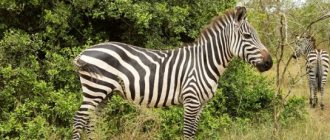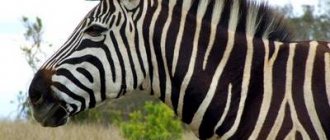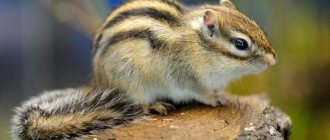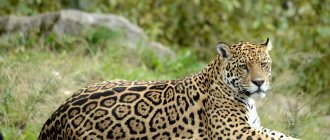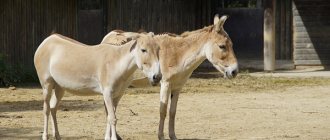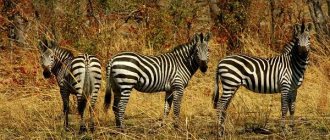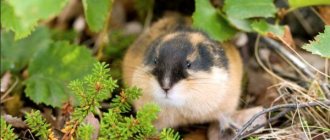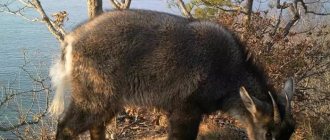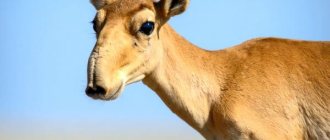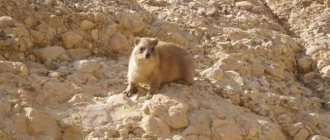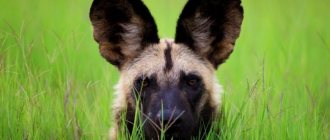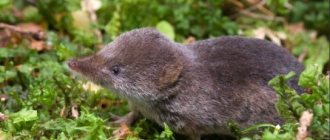Hi all! Today our guest is Musang, a beast whose poop is worth more than gold! Greetings, faunaphiles. I'm sure you rarely think about the composition of goodies from the store. It’s true, the less you know, the better you sleep.
It’s better not to think about the complex chemical names that make up your favorite chocolate bar. In this case, you are unlikely to get pleasure from it. But there are real gourmets, and they pay exorbitant amounts of money to eat... poop. And in the most literal sense!
Our story today is about an animal whose feces are worth its weight in gold - the Musang or the Malayan Palm Civet.
Description of musangs
A small and nimble predatory mammal belonging to the Viverridae family, it has a very characteristic appearance . In their appearance, musangs vaguely resemble a ferret and a cat. Since 2009, the issue of adding several endemics to the territory of Sri Lanka to the three existing species of musang has been considered.
Appearance
The average body length of an adult musang is about 48-59 cm, with a total tail length of 44-54 cm. The weight of a mature predatory animal varies from 1.5-2.5 to 3.8-4.0 kg. Musangs have a very flexible and elongated body on short but strong legs, which have the usual retractable claws, like those of any cat. The animal is distinguished by a wide head with a narrow muzzle and a large wet nose, very large bulging eyes, as well as fairly widely spaced and rounded ears of medium size. The teeth are short, rounded, and the molars have a pronounced square shape.
This is interesting! Thanks to the presence of special scent glands, Malayan palm civets received their unusual nickname - hermaphrodites (hermaphroditus).
The paws and muzzle, as well as the ears of this wild animal, are noticeably darker than the color of the body. There may be whitish spots in the muzzle area. The coat of the animal is quite hard and thick, in grayish tones. The fur is represented by a soft undercoat and a tougher outer coat.
Character and lifestyle
Musangs are typical nocturnal animals . During the daytime, such small animals try to sit comfortably on tangles of vines, among tree branches, or quite easily and quickly climb into squirrel holes, where they go to sleep. Only after sunset do they begin active hunting and searching for food. At this time, Malayan palm martens very often make shrill and extremely unpleasant sounds. Thanks to the presence of claws and the structure of the limbs, musangs are able to move very well and quickly through trees, where such a mammalian predator spends a significant part of its free time. If necessary, the animal runs neatly and quickly enough on the ground.
This is interesting! Due to the small number of currently existing representatives of the species, as well as their nocturnal lifestyle, the behavioral characteristics of the Sri Lankan musang are poorly studied.
Sometimes Malayan palm civets settle on the roofs of residential buildings or stables, where they scare residents at night with loud noise and characteristic screams. However, the small and incredibly active predator brings enormous benefits to humans, destroying very large numbers of rats and mice, as well as preventing epidemics spread by these rodents. Palm martens lead a preferentially solitary lifestyle, so this predatory mammal unites in pairs exclusively during the mating season for reproduction.
How long does a musang live?
The average, officially registered life expectancy of a musang in the wild is between 12-15 years, and a domestic predatory animal can easily live up to twenty years, but domesticated individuals are known whose age was almost a quarter of a century.
Sexual dimorphism
Females and males of the musang have special glands resembling testicles, which secrete a special odorous secretion with a characteristic musky odor. As such, pronounced morphological differences between males and females of the same species are completely absent. Females have three pairs of nipples.
Return to content
Mustangs in culture
Although wild horses spread throughout the New World, people outside of America learned about them not from the Spaniards, but from the inhabitants of the United States. Moreover, the term “Mustang” is Spanish in origin. In Spanish-speaking countries of the Americas, including Mexico, the words “mestengo”, “mesteño” and “mostrenco” were used, which in different dialects of Spanish mean “stray (feral or no one’s) livestock.
Mustangs have left a significant mark on the culture of modern America. They have become a symbol of the uncontrollable thirst for freedom, free spirit and freedom itself. For example, it is believed that mustangs, when running away from cowboys trying to lasso them, consciously throw themselves off rocky ledges in order to prevent themselves from being pinned down. In reality, this is, of course, just a myth, but it shows well how Americans perceive wild horses. Therefore, in most photos the Mustang horse is captured in a proud, uncontrollable gallop.
Strong and graceful, horses themselves seem to be very majestic animals, and mustangs, due to their love of freedom, are doubly majestic. It is not surprising that many creative individuals used their image in their works. Artists willingly depicted Mustangs on their canvases; they were often mentioned in prose and poetry, and were in demand for depiction in films and cartoons. Very indicative in this regard is the relatively recent animated film Spirit: Soul of the Prairie, which depicts an archetypal mustang yearning for freedom.
Finally, the iconic model of the Ford Mustang sports car, produced in the USA for more than half a century, was named in honor of wild mustangs. By giving the car such a name, the creators sought to emphasize that it was as strong, graceful, fast, beautiful and freedom-loving as a wild mustang galloping across the prairies.
It would not be an exaggeration to say that in a sense, Americans consider the mustang to be a symbol of America itself and the American people. In this regard, it is very easy to draw a parallel between freedom-loving wild horses and settlers from Europe who were looking for freedom for themselves and their children in the New World.
Types of musangs
The main difference between representatives of different types of mustangs is the difference in the color of their coat:
- The Asian Musang has a gray coat with black stripes along the entire body. Only closer to the abdominal area do such stripes lighten and gradually turn into spots;
- The Sri Lankan Musang is a rare species with a coat ranging from dark brown to light brownish-red and bright gold to reddish-gold. There are also individuals with a fairly faded light brown coat color;
- South Indian Musang - distinguished by a solid brown color, with darkening of the fur around the neck, head, tail and paws. Sometimes there is gray hair on the coat. The color of this animal is extremely diverse, ranging from pale beige or light brown to dark brown shades. The dark tail sometimes has a pale yellow or pure white tip.
This is interesting! Musangs have the largest number of subspecies among the representatives of the Viverridae family, including Ph hermaphroditus, Ph bondar, Ph canus, Ph dongfangensis, Ph exitus, Ph kangeanus, Ph lignicolor, Ph minor, Ph nictitans, Ph pallasii, Ph parvus, Ph pugnax, Ph pulcher, Ph scindiae, Ph setosus, Ph simplex and Ph vellerosus.
Brown representatives have similar patterns, having a brownish color, and the golden musang has a predominant golden brown color with iridescent hair tips.
Return to content
Taming the Mustang
Six thousand years ago, people already managed to tame wild tarpans, from which modern horses emerged. Therefore, it is even easier to tame feral mustangs. However, there are some difficulties due to the fact that US laws protect mustangs as a valuable and rare wild animal. However, a certain number of wild horses live in a special type of reservation, where they are not considered wild in the full sense, and therefore they can be caught.
Looping a mustang and delivering it to the stable is a relatively simple task in technical terms. The difficulty is different: the mustang still remains wild. It is not for nothing that domestic horses begin to be broken at a young age. It is much more difficult to train an old horse to walk under saddle than a young one. Making a mustang walk under saddle is even more difficult, because it has grown and developed as a “personality” without knowing a person at all. Accordingly, the process of taming and training will be quite long and tedious.
Finally, after taming and training, you still end up with essentially a mongrel horse that has a very mediocre exterior. On the other hand, the mustang is very strong, resilient and capable of jumping quickly. And he is not at all picky about his living conditions, because from an early age he was accustomed to eating sparse vegetation and drinking ice-cold water.
By the way, due to the fact that mustangs are found only in America, taming and training a wild horse is still half the cost. After all, it needs to be delivered to Russia halfway around the world, which will require considerable additional costs. As a result, you will get a very expensive horse, which, most likely, will have a bad character and not the best athletic characteristics.
Range, habitats
Malayan palm civets or Malayan palm civets have become quite widespread in South and Southeast Asia. The Musang's habitat is represented by India, southern China, Sri Lanka, Hainan Island and the Southern Philippines, as well as Borneo, Sumatra, Java and numerous other islands. The natural habitat of the predatory animal is tropical forest zones.
The South Indian musang or brown strangetail is an inhabitant of subtropics and tropical forests, which are located at an altitude of 500-1300 meters above sea level. Often such animals are found near tea plantations and human habitation. Sri Lankan musangs prefer the most humid habitats, including evergreen mountain, tropical and monsoon forest zones, living mainly in the crowns of the largest trees.
Return to content
Musang diet
The main, predominant part of the diet of Sri Lankan musangs is represented by all kinds of fruits . Predatory animals with great pleasure eat quite a large number of mangoes, coffee, pineapples, melons and bananas. Occasionally, palm martens also eat various small vertebrates, including not too large birds and snakes, as well as lizards and frogs, bats and worms. The diet of adult musangs also includes a wide variety of insects and fermented palm sap called toddy, which is why locals often call such animals toddy cats. Occasionally, animals settling near human habitation steal all kinds of poultry.
Classified as omnivores, mussangs consume a wide variety of food types, but have become famous for consuming grain from coffee plantations. Such undigested grains make it possible to obtain the most delicious and most expensive type of coffee, Kopi Luwak. When eating coffee fruits, the animals excrete them in almost undigested, pure form. However, under the influence of natural enzymes, some processes take place in the intestinal tract of the musang that significantly improve the quality characteristics of coffee beans.
Return to content
Nutrition
The basis of the musang's diet is plant food - in addition to coffee berries, the animals adore ripe fruits and some plants. But at the same time, they are not at all averse to destroying a nest and gobbling up bird eggs, they can catch small birds, and feast on small rodents, lizards, insects and their larvae.
In captivity, animals will happily feast on fruits and vegetables, fresh dairy products, low-fat meat, eggs and grains.
Reproduction and offspring
Musangs reach sexual maturity at approximately one year of age. A sexually mature female mustang approaches the male only during the period of active mating. After a couple of months, not too many offspring are born in a pre-arranged and prepared hollow. As a rule, babies are born between early October and mid-December. Female Sri Lankan musangs can have two litters during the year.
Most often, in one musanga litter, from two to five blind and completely defenseless cubs are born, with a maximum weight of about 70-80 grams. On the eleventh day, the babies' eyes open, but they continue to feed on the female's milk until they are two months old.
The female protects and feeds her offspring until the age of one year, after which the grown and strengthened animals become completely independent.
Return to content
Mustang lifestyle
Like their ancient ancestors, modern wild horses live in herds, each of which contains an average of 15-20 individuals. In rare cases more. Large herds with dozens or hundreds of heads are nothing more than an artistic fantasy. Each such “family” has its own territory, which has to be protected from competitors.
The herd has a simple hierarchy: one alpha male and one main female. The alpha male sets the direction for the movement of the herd, “organizes” (if one can say so about wild animals) defense from predators, and also has the unconditional right to mate with any female in the herd. The alpha male is forced to defend his dominance in regular clashes with contenders for the “throne.” Except for these skirmishes, the other males always obey him unconditionally.
The main mare is a kind of “deputy” for the alpha male. She leads the herd if the main male is busy fighting with contenders or predators. At the same time, other males always obey her. The status of the main female is determined not by strength and experience, but by fertility, so there are almost no fights for leadership between females.
The defense strategy undertaken by the mustangs in the face of danger is interesting. The herd is built into a figure that vaguely resembles a military square: in the center of the circle there are foals and females, and along the perimeter there are males, with their muzzles turned towards the center and the croup towards the predator. In this position, males can use their main weapon - their hind hooves. Unfortunately, it is not so easy to find videos of mustang horses performing this figure, but in real life this tactic looks very spectacular.
A classic example of a herbivore, mustangs feed on wild grasses and some shrubs. Today, wild horses have been forced out by humans onto lands that are unsuitable for agriculture, that is, poor in vegetation and surface water. For this reason, herds have to travel tens of kilometers a day in search of grass and water. Since it is the alpha male who leads the herd, one of the most important qualities for him is great experience and a good memory to lead the herd to water or pasture. Because of this, young, inexperienced males never become leaders.
The breeding cycle for mustangs begins in the spring. Mating can continue until early summer, with males having to fight fiercely to prove their right to access the females. Thanks to the fact that only the strongest win, the mustang gene pool is constantly improving.
Pregnancy for females lasts 11 months, meaning foals are born the following spring. As a rule, a mare gives birth to only one foal; the birth of two is more of a pathology than the norm. For the first six months, the young animals feed on their mother’s milk, and then switch to pasture. Photos of mustang horses with foals are one of the cutest sights.
Natural enemies
People traditionally hunt the Sri Lankan musang for its beautiful skin and delicious, quite nutritious, tasty meat . Also, in alternative medicine, the healing internal fat of Asian musangs, infused with a certain amount of well-refined flaxseed oil, is widely used.
This is interesting! In recent years, the popularity of musangs as pets has sharply increased, which are actively caught in the wild and quickly tamed, becoming affectionate and good-natured, like ordinary cats.
This composition is very ancient and, according to many doctors, a highly effective cure for complex forms of scabies. In addition, civet extracted from musangs is actively used not only in medicine, but also in the perfume industry. The animals are often destroyed as animals that harm coffee and pineapple plantations, as well as poultry yards.
Return to content
The history of the mustang horse
Archaeological historians have established that there were once wild horses on the American continent, but for reasons that remain not entirely clear, they became extinct about ten thousand years ago. Thus, by the time Europeans arrived in America, there were no more horses. In the first stages of colonization, the Spaniards often used horses to give themselves a more majestic appearance, because in the eyes of the Indians, a rider on an unprecedented horse seemed almost a deity.
As the continent progressed and relations between the Indians and Europeans deteriorated, feral horses began to appear. In military skirmishes, horses that lost their riders ran away, frightened by the noise of the battle. In addition, the natives, who sometimes managed to take possession of horses as trophies, did not always know how to use them, and therefore simply abandoned them. Finally, horses simply ran away from pastures and night stops of European colonialists.
Since the horse is a herd animal, solitary escapees quickly formed groups and began to reproduce, further increasing the population of wild horses. The growth rate of wild herds was so high that by the beginning of the 19th century, numerous herds of these animals were found everywhere in the steppe regions of both Americas from Paraguay in the south to Canada in the north. By this time, the number of wild mustang horses in the territory now occupied by the United States alone was at least 2 million.
During this period, feral horses were a popular hunting object, from which they obtained a lot of meat and quality leather. However, soon the scale of hunting exceeded the ability of the herds to replenish losses, and the population began to decline rapidly. The sharp decline in wild horse numbers has also been influenced by the expansion of arable land and fenced pastures for farm animals. As a result, by the beginning of the 20th century, the total number of wild mustangs, according to estimates, fell to several hundred thousand.
Interestingly, at the beginning of the last century, the Americans captured a huge number of mustangs in order to use them in the American-Spanish and First World Wars. Thus, by the 1930s, there were only between 50 and 150 thousand wild horses in the United States. By the 1950s, the population had dropped even further, to 25,000.
In connection with the threat of extinction of wild horses in the United States, a number of laws were passed limiting, and subsequently completely prohibiting, the hunting of mustangs. Today, the number of American mustang horses (that is, those living in Canada and the USA), according to various sources, ranges from 25 to 35 thousand heads.
Video about musangs
Return to content
Tags: paradoxurus hermaphroditus, Asian musang, habitat, appearance, wild animals, musang, common musang, nutrition, population, natural enemies, reproduction, diet, Sri Lankan musang, South Indian musang
